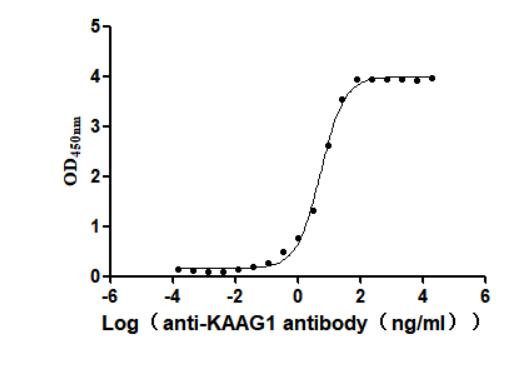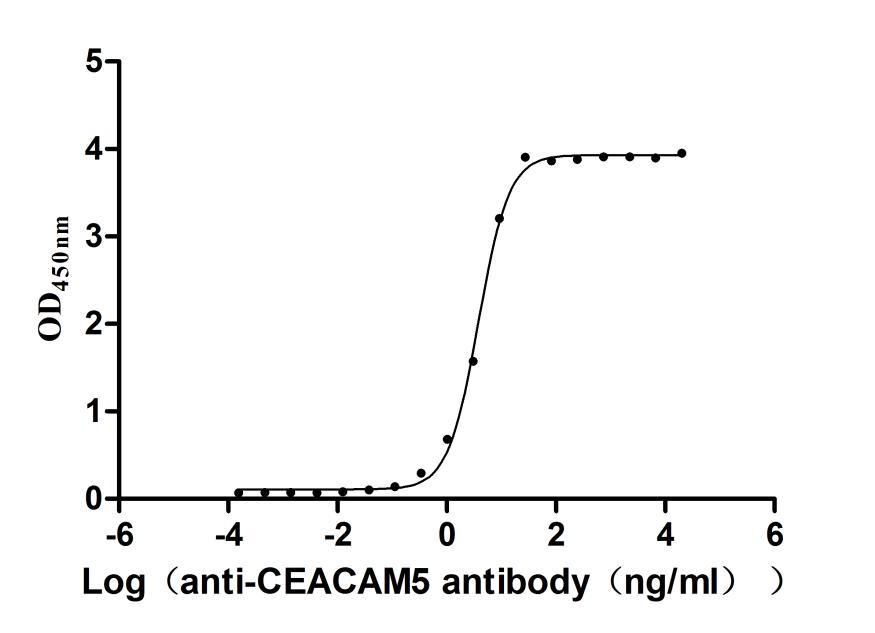Recombinant Rat P2X purinoceptor 7 (P2rx7), partial
-
货号:CSB-YP731066RA
-
规格:
-
来源:Yeast
-
其他:
-
货号:CSB-EP731066RA
-
规格:
-
来源:E.coli
-
其他:
-
货号:CSB-EP731066RA-B
-
规格:
-
来源:E.coli
-
共轭:Avi-tag Biotinylated
E. coli biotin ligase (BirA) is highly specific in covalently attaching biotin to the 15 amino acid AviTag peptide. This recombinant protein was biotinylated in vivo by AviTag-BirA technology, which method is BriA catalyzes amide linkage between the biotin and the specific lysine of the AviTag.
-
其他:
-
货号:CSB-BP731066RA
-
规格:
-
来源:Baculovirus
-
其他:
-
货号:CSB-MP731066RA
-
规格:
-
来源:Mammalian cell
-
其他:
产品详情
-
纯度:>85% (SDS-PAGE)
-
基因名:
-
Uniprot No.:
-
别名:P2rx7; P2X purinoceptor 7; P2X7; ATP receptor; P2Z receptor; Purinergic receptor
-
种属:Rattus norvegicus (Rat)
-
蛋白长度:Partial
-
蛋白标签:Tag type will be determined during the manufacturing process.
The tag type will be determined during production process. If you have specified tag type, please tell us and we will develop the specified tag preferentially. -
产品提供形式:Lyophilized powder
Note: We will preferentially ship the format that we have in stock, however, if you have any special requirement for the format, please remark your requirement when placing the order, we will prepare according to your demand. -
复溶:We recommend that this vial be briefly centrifuged prior to opening to bring the contents to the bottom. Please reconstitute protein in deionized sterile water to a concentration of 0.1-1.0 mg/mL.We recommend to add 5-50% of glycerol (final concentration) and aliquot for long-term storage at -20℃/-80℃. Our default final concentration of glycerol is 50%. Customers could use it as reference.
-
储存条件:Store at -20°C/-80°C upon receipt, aliquoting is necessary for mutiple use. Avoid repeated freeze-thaw cycles.
-
保质期:The shelf life is related to many factors, storage state, buffer ingredients, storage temperature and the stability of the protein itself.
Generally, the shelf life of liquid form is 6 months at -20°C/-80°C. The shelf life of lyophilized form is 12 months at -20°C/-80°C. -
货期:Delivery time may differ from different purchasing way or location, please kindly consult your local distributors for specific delivery time.Note: All of our proteins are default shipped with normal blue ice packs, if you request to ship with dry ice, please communicate with us in advance and extra fees will be charged.
-
注意事项:Repeated freezing and thawing is not recommended. Store working aliquots at 4°C for up to one week.
-
Datasheet :Please contact us to get it.
靶点详情
-
功能:Receptor for ATP that acts as a ligand-gated ion channel. Responsible for ATP-dependent lysis of macrophages through the formation of membrane pores permeable to large molecules. Could function in both fast synaptic transmission and the ATP-mediated lysis of antigen-presenting cells.
-
基因功能参考文献:
- These results indicated that gardenoside may be able to relief chronic constriction injury (CCI)-induced neuropathic pain by regulating the P2X3 and the P2X7 expression on the ischiadic nerve PMID: 29932348
- GRGM-13 could inhibit oxidative stress-induced RGCs apoptosis via inhibiting P2RX7/p38MAPK pathway. PMID: 29501771
- these results indicate that silencing BC168687 expression may downregulate the increased expression of P2X7 receptors in SGCs induced by a HGHF environment. PMID: 29436679
- lncRNA BC168687 may participate in the pathogenesis of DNP mediated by P2X7 receptor, which will provide a novel way for the study of the pathogenesis of diabetes mellitus complicated with neuropathic pain and its prevention and treatment. PMID: 29204447
- These data reinforce the participation of P2X7R in mechanisms underlying the increase in hyperexcitability, edema, and cell death triggered by pilocarpine-induced status epilepticus PMID: 28707031
- P2X7 receptor inhibition attenuated sympathetic nerve sprouting after myocardial infarction via the NLRP3/IL1B pathway. PMID: 28470940
- results show that pharmacological inhibition of the P2X7 receptor is well tolerated in Charcot-Marie-Tooth type 1A rats PMID: 27431093
- Inhibition of p38 MAPK signaling decreased nc021972-induced expression of the P2X7 receptor and [Ca(2+)]i increment upon P2X7 receptor activation PMID: 26865268
- increased P2X7 mRNA and protein levels and the increased p-ERK1/2 expression in the SCG were also reduced PMID: 27215605
- NONRATT021972 siRNA treatment effectively suppressed the increase in [Ca(2+)]i induced by OGD or P2X7 agonists (ATP or BzATP) in PC12 cells PMID: 27100355
- We speculate that the intracellular Ca(2+) signalling triggered by P2X7 receptor activation may be an epigenetic mechanism to modulate the behaviour of progenitors in response to ATP released after spinal cord injury. PMID: 26988236
- Data suggest that the vascular response to stretch injury is associated with release of ATP and activation of the P2X7R/P38 MAPK pathway, resulting in contractile dysfunction. PMID: 28807217
- lncRNA uc.48+ siRNA improved diabetic sympathetic neuropathy in type 2 diabetic rats through regulating the expression of P2X7 and ERK signaling in superior cervical ganglia PMID: 27118262
- Data suggest that specific serine residues in purinergic receptors play key roles in both agonist binding and receptor sensitization/desensitization: in rat P2rx7, point mutation F288S (phenylalanine 288 > serine) results in a slower rate of ATP binding/unbinding and stabilization of non-sensitized receptor states; in human P2RX7, Y288F (but not Y288S) results in a "rat-like" receptor with a fast deactivation rate. PMID: 28616989
- reactivated Muller cells may release excessive ATP, in turn leading to RGC apoptosis through activating P2X7 receptors in these cells. PMID: 27720859
- Together, we show for the first time, that deficiency of P2X7R prevents in vivo oxidative stress-induced accumulation of MPs and AMD-like defects. This work could potentially lead to novel therapies for AMD and other oxidative stress-driven diseases. PMID: 27810364
- HSP90 may be essential for stabilization and function of P2X7Rs through an action on the cysteine-rich domain of the cytoplasmic the C-terminus. PMID: 27301716
- this study shows that P2X7R mediated acetaldehyde-induced activation of hepatic stellate cells via PKC-dependent GSK3beta pathway, which maybe a novel target for limiting the development of alcoholic liver fibrosis PMID: 28061416
- Localized inhibition of P2X7R for two weeks can be associated with reduced number of microglia and attenuated bladder hyperexcitability mediated by downregulation of urothelial P2X3R in rats with neurogenic bladder dysfunction and independently of locomotor improvements PMID: 28039004
- The administration of P2X7 R RNAi during the acute inflammatory response phase prevented the process of sympathetic hyperinnervation after MI, which was associated in part with inhibiting the Akt and ERK1/2 pathways and NF-kappaB activation. PMID: 28039938
- results suggest that activated Muller cells may release ATP and, in turn, induce upregulation of P2X7R expression in the cells of ganglion cell layer , thus contributing to Retinal Ganglion Cell death. PMID: 27738636
- endogenous P2X7 receptor increased at 3 hours after intracerebral hemorrhage (ICH) with a peak at 24 hours, then returned to normal level at 72 hours after ICH. PMID: 26980524
- Data indicate that naringin up-regulated expression of the purinergic receptor P2X 7 (P2X7) in the hippocampus. PMID: 27363267
- siRNA treatment prevented the pathophysiologic processes mediated by P2X7 receptors in the SG after myocardial ischemic injury PMID: 26630943
- NONRATT021972 siRNA treatment can decrease the expression levels of P2X7 mRNA and protein. PMID: 27107575
- Thus, activation of P2X7R induces microvascular dysfunction and regional hypoxia when angiotensin II is elevated and these effects may contribute to progression of renal injury induced by chronic angiotensin II. PMID: 26108066
- Myocardial expression of the harmful P2X7 subtype is increased in coronary ischemia-reperfusion injury. PMID: 26070527
- Disruption of the Na+ gradient by P2X7 receptor activation downmodulates high-affinity GABA and glutamate uptake into rat cortical synaptosomes. PMID: 26299340
- that P2X7 plays a critical role in mediating calcium signaling and coordinating cytoskeletal rearrangement PMID: 26683661
- effect of P2 x 7R activation on osteogenic and adipogenic differentiation of bone marrow stromal cells in vitro PMID: 26481422
- Study demonstrates an involvement of P2X7 receptors in the regulation of axon initial segment mediated neuronal excitability in physiological and pathological conditions PMID: 24610121
- Results suggest that targeting P(2)X(7) may be bi-effective in the treatment of central post-stroke pain, as both a pain blocker and immunosuppressant that inhibits inflammatory damage to brain tissue. PMID: 25836422
- P2X7R may be involved in proliferation of Schwann cells PMID: 25682129
- P2X7 receptor of rat dorsal root ganglia is involved in the effect of moxibustion on visceral hyperalgesia PMID: 25527178
- exposure to chronic restraint stress produces a pronounced and relatively persistent suppression of the P2X7 receptor within the hippocampus. PMID: 24989856
- ATP induces the acrosome reaction in capacitated rat spermatozoa through a P2X7 receptor, which may be functional during in vivo fertilization. PMID: 25989529
- These findings identify new residues involved in pore formation of P2X7R. PMID: 25712548
- The purinergic system contributes to functional neuromuscular changes associated with bowel inflammation via P2X7Rs, which modulate the activity of excitatory cholinergic nerves through a facilitatory control on inhibitory nitrergic pathways. PMID: 25549098
- findings suggest that P2X7R participates in aversive memory processes PMID: 25239372
- Cultured hippocampal neurons, in contrast to astrocytes, possess P2X7 receptors, if at all, only at a low density. PMID: 24961463
- Study indicates that peripheral P2X7 receptor activation induces mechanical hyperalgesia via inflammatory mediators, especially bradykinin PMID: 24997266
- These results show that P2X7 receptors and pannexin-1 channels are major mediators of postanoxic depolarization in neurons and of brain damage after ischemia PMID: 25605289
- Results show that P2X7 receptor participated in the pathophysiological process of neuronal damage induced by oxygen-glucose deprivation PMID: 24746144
- Results show that substantia gelatinosa astrocytes possess P2X7 receptors; their activation leads to the release of glutamate, which via NMDA- and AMPA receptor stimulation induces cationic current in the neighboring neurons PMID: 24895290
- P2X7 receptor inhibition could represent a novel approach to the treatment of inflammatory arthritis. PMID: 25288220
- The results of this study suggest a contribution of P2X7Rs in the spinal dorsal horn to paclitaxel-induced allodynia and may provide new therapeutic targets for paclitaxel-induced painful neuropathy. PMID: 25127716
- results suggest that Wnt3a overrides the effect of P2X7R on the Wnt/beta-catenin signaling to prevent the AEC I death and restrict the severity of ALI. PMID: 24922070
- role of P2X purinoceptor 7 in neurogenic pulmonary edema after subarachnoid hemorrhage PMID: 24533168
- These results indicate that antagonism of the P2X7 receptor and signaling pathways of microglial MV shedding, such as src-protein tyrosine kinase, P38 MAP kinase and A-SMase. PMID: 23877788
- JNJ-47965567 is centrally permeable, high affinity P2X7 antagonist. PMID: 23889535
显示更多
收起更多
-
亚细胞定位:Cell membrane; Multi-pass membrane protein.
-
蛋白家族:P2X receptor family
-
数据库链接:
KEGG: rno:29665
STRING: 10116.ENSRNOP00000001746
UniGene: Rn.10510
Most popular with customers
-
Recombinant Human Tumor necrosis factor ligand superfamily member 8 (TNFSF8), partial (Active)
Express system: Mammalian cell
Species: Homo sapiens (Human)
-
Recombinant Mouse Claudin-18 (Cldn18)-VLPs (Active)
Express system: Mammalian cell
Species: Mus musculus (Mouse)
-
Recombinant Human Claudin-3 (CLDN3)-VLPs (Active)
Express system: Mammalian cell
Species: Homo sapiens (Human)
-
Recombinant Human Cytotoxic and regulatory T-cell molecule (CRTAM), partial (Active)
Express system: Mammalian cell
Species: Homo sapiens (Human)
-
Recombinant Human Carcinoembryonic antigen-related cell adhesion molecule 8(CEACAM8) (Active)
Express system: Mammalian cell
Species: Homo sapiens (Human)
-
Recombinant Human B- and T-lymphocyte attenuator(BTLA), partial (Active)
Express system: Mammalian cell
Species: Homo sapiens (Human)
-
Recombinant Human Kidney-associated antigen 1(KAAG1) (Active)
Express system: Baculovirus
Species: Homo sapiens (Human)
-
Express system: Mammalian cell
Species: Macaca mulatta (Rhesus macaque)



-AC1.jpg)
















